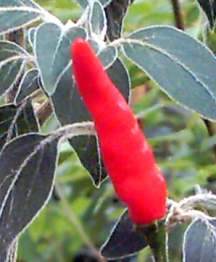|
|
Peppers
- A Short Study
| Introduction:
Our
pungent peppers of hot sauce, picante and Pico de Gallo are misnamed.
Since it is increasingly popular to do so, we shall also blame Columbus.
The Jewish gentleman from Genoa sailed to the Orient (so he thought) to
find black pepper, other rare spices, and fortune. Instead, he found something
far better, Capsicum, but still called it pepper. Actually, he used
the Spanish word for pepper. The names the aboriginals used for the
pungent fruits also live on.
The natives Columbus encountered
called it, aji, which is still used in the Caribbean as well as South America.
The Aztec name has given us the word, chile. |
 |
******'Chile
de Arbol'
|
|
Taxonomy
of Capsicum:
The
unique place held by the peppers, Capsicum, in the plant kingdom
is as follows:
Division:
Magnoliophyta
(Angiosperms)
Class: Magnoliopsida
(Dicotyledons)
Order: Solanales
Family: Solanaceae
Genus: Capsicum L.
Domesticated species include: C. annuum, C. baccatum, C.
chinense & C. pubescens
While there are four species
in general cultivation, the most common one in gardens or grocery stores
in the U.S. is C. annuum,
with three recognized varieties. Its name
notwithstanding, C. annuum is actually a perennial, not an annual.
Its perennial nature is best appreciated in the frost-free regions of Africa,
Asia and Latin America, or in a greenhouse.
Botanical
Varieties of Capsicum annuum L.
|
Variety
|
Synonym
|
Common Name
|
| Capsicum annuum L.
var.
annuum |
Capsicum baccatum
auct. non L.
Capsicum frutescens
sensu Standl., non L. |
Bell Pepper, Cayenne, Chile
Pepper, Hot Pepper, Jalapeño |
| Capsicum annuum L.
var.
frutescens (L.) Kuntze |
Capsicum frutescens
L. |
Tabasco, Tabasco Pepper |
| Capsicum annuum L.
var.
glabriusculum (Dunal) Heiser & Pickersgill |
Capsicum annuum var.
aviculare (Dierbach) D'Arcy & Eshbaugh
Capsicum annuum var.
minus (Fingerhuth) Shinners |
Bird Pepper, Chile Piquin,
Chiltecpin, Chiltepin, Piquin, Tepin |
In addition, many more species
of Capsicum have been identified, all native to the New World:
Species
of Capsicum
|
Currently Accepted
Species
|
Distribution
|
|
annuum L.
|
Colombia to S United
States
|
|
baccatum L.
|
Argentina, Bolivia,
Brazil, Paraguay, Peru
|
|
buforum Hunziker
|
Brazil
|
|
campylopodium
Sendt.
|
S Brazil
|
|
cardenasii Heiser
& Smith
|
Bolivia
|
|
chacoense Hunziker
|
Argentina, Bolivia,
Paraguay
|
|
chinense Jacq.
|
Caribbean, Central &
South America
|
|
coccineum (Rusby)
Hunziker
|
Bolivia, Peru
|
|
cornutum (Hiern)
Hunziker
|
South Brazil
|
|
dimorphum (Miers)
O. K.
|
Colombia
|
|
dusenii Bitter
|
SE Brazil
|
|
eximium Hunziker
|
Argentina, Bolivia
|
|
glapagoensis
Hunziker
|
Ecuador
|
|
geminifolium
(Dammer) Hunziker
|
Colombia, Ecuador
|
|
hookerianum (Miers)
O. K.
|
Ecuador
|
|
lanceolatum (Greenm.)
Morton & Standley
|
Mexico, Guatemala,
|
|
leptopodum (Dunal)
O. K.
|
Brazil
|
|
minutiflorum
(Rusby) Hunziker
|
Argentina, Bolivia,
Paraguay
|
|
mirabile Mart
ex. Sendt
|
S Brazil
|
|
parvifolium Sendt.
|
Colombia, NE Brazil,
Venezuela
|
|
praetermissum
Heiser & Smith
|
S Brazil
|
|
pubescens Ruiz
& Pavon
|
Central & South
America
|
|
scolnikianum
Hunziker
|
Peru
|
schottianum Sendt.
(includesC. flexuosum
Sendt.)
|
Argentina, S Brazil,
SE Paraguay
|
tomentosum Eshbaugh
& Smith
(C. eximium var.
tomentosum
Eshbaugh & Smith)
|
Argentina, Bolivia
|
|
tovarii Eshbaugh,
Smith & Nickrent
|
Peru
|
|
villosum Sendt.
|
S Brazil
|
|
Invalid Capsicum
Species:
|
|
|
C. anomalum, C. breviflorum
& C. ciliatum
|
This table is based
on the works of Heiser, Hunziker, Eshbaugh, Pickersgill & others.
|
|
|
Ethnobotany
of Capsicum
One
aspect of ethnobotany is an examination of the names given to plants and
how pre-industrial cultures have classified the flora of their surroundings.
Nahuatl is one of the best known pre-Columbian languages of the New World.
It was and still is spoken by peoples in central Mexico, by the Aztecs
and those they conquered. This is a glossary of Nahuatl terms associated
with Capsicum and its edible fruits. Many of these words
are still used in Mexico:
Chilaquiles - a dish made
from torn pieces of tortillas, chiles, epazote, etc. - from chilli
(chile) and quilitl (greens, herbs)
Chilate - a drink made from
chiles, with cacao and ground, toasted corn - from chilli (chile) and atl
(water)
Chilchote - a green-fruited
Capsicum
-
from chilchotl (green chile)
Chilcostle - a yellow-fruited
Capsicum
-
from chilli (chile) and cóztic (yellow)
Chile
- the edible fruit of Capsicum - from chilli (chile), itself possibly
derived from chíltic (red)
Chilhuaque
- dried chile - from chilli (chile) and huaqui (dried)
Chilmole
- a thin chile "soup" in which meats and/or beans are cooked - from chilli
(chile) and molli (chile sauce)
Chilocle
- a drink made with pulque, chile and other ingredients - from chilli (chile)
and octli (wine)
Chipotle
- variant of chilpotle
Chilpoctle
- variant of chilpotle
Chilpotle
- a pepper dried and cured by exposure to smoke - from chilli (chile) and
poctli (smoke)
Chiltecpin
- the name of Capsicum annuum L.
var. glabriusculum,
a shrubby plant with small fruits, also known as: Bird Pepper, Chile Piquin,
Chiltepin, Piquin, Tepin - from chilli (chile) and tecpin (flea)
Chiltepin
- see chiltecpin
Chiltipin
- variant of chiltecpin - from chilli (chile) and tipitzin (small)
Chilzolote
- a dried or old chile - from chilli (chile) and zoloa (to make old)
Chincuayo
- a wild Capsicum with violet petals - from tzintli (tail), cuáhuitl
(tree) and yo (possessive ending)
Cócoc - spicy, that
which burns the mouth
Guacamole
- a mixture of avocado and chiles - from ahuácatl (avocado) and
molli (mole or chile sauce)
Pétztic - brilliant,
fulgent, polished
Tonalchile - a green-fruited
Capsicum
- from tonalli (heat from the sun) and chilli (chile)
Tornachile
- see tonalchile
**********
Another
aspect of ethnobotany is an examination of the uses of a plant by
a culture. Aside from being edible and nutritious, the fruits of
Capsicum are reputed to have numerous medicinal uses. For example,
the following applications have been recorded for Cayenne Pepper:
"1.
The ability to prevent or even stop a heart attack by increasing heart
action without raising blood pressure
2. Thins blood, reducing
the risk of stroke.
3. Acts as an internal disinfectant
it can detoxify the colon and help with eliminative functions
4. Topical pain reliever.
5. If you have a cut it
can stop the bleeding.
6. Relieves pain from stomach
ulcers by creating more mucous and coating the wall of the stomach.
7. Can knock out cold and
flu miseries.
8. Used as a gargle, it
can relieve sore throat pain.
9. Diabetes may take it
to lower their blood sugar levels.
10. Cayenne is also very
high in vitamin C so it acts as a preventative against respiratory infections
and can help strengthen the immune system.
11. It has also been proposed
that the capsaicinoids might be useful in fighting cancer."
This page
is designed for informational or educational purposes only and has not
been evaluated by the Food and Drug Administration. It is not intended
to promote any specific products, or to be a substitute for professional
medical advice, diagnosis or treatment. Always seek the advice of a qualified
health-care professional with any questions you may have regarding a medical
condition or symptom.
|
|
| Heat Scales:
The
pungency of a particular fruit depends not only on its genetic makeup,
but also on many physical and cultural factors. Capsaicin content varies
depending on where on the plant the fruit is located; when in the growing
season it matures; soil type; nutrients available at the root zone; quality,
quantity and frequency of irrigation or rainfall; and amount of sunlight
received by the plant.
Quantifying the relative
heat content of peppers was a part of the vocabulary of the Aztecs.
Their Nahuatl language contains the following colorful expressions of taste
bud pain:
Nahuatl
- Pepper Heat Scale
|
cócoc
|
hot
|
|
cócpatic
|
very hot
|
|
cócopetz-patic
|
very, very hot
|
|
cócopétztic
|
brilliant hot
|
|
cócpetzquauitl
|
extremely hot
|
|
cócpaalatic
|
runaway hot
|
|
A
more modern method of determining the heat content of the fruits was developed
by Wilbur Scoville in 1912. In the chart below, a range of values is given
when several testings of a cultivar have yielded varying heat content.
Where only one value is given, it indicates the result of a single test.
Scoville
Heat Unit Scale
|
Pepper Variety
|
Scoville Heat Units
|
|
100% Capsaicin
|
16,000,000
|
|
Dorset Naga (C. chinense)
|
900,000 ~ 923,000
|
|
Naga Jolokia (C.
chinense)
|
855,000
|
|
Red Savina Habanero
(C. chinense)
|
350,000 ~ 577,000
|
|
Habanero, Scotch Bonnet
(all C. chinense)
|
150,000 ~ 325,000
|
|
Bird's Eye (C. annuum)
|
100,000 ~ 225,000
|
|
Jamaican Hot (C.
annuum)
|
100,000 ~ 200,000
|
|
Carolina Cayenne (C.
annuum)
|
100,000 ~ 125,000
|
|
Tabiche
|
85,000 ~ 115,000
|
|
Thai (C. annuum)
|
50,000 ~ 100,000
|
|
Yatsafusa
|
50,000 ~ 75,000
|
Chile Piquin, Chiltecpin,
Chiltepin,
Piquin, Tepin (all C.
annuum)
|
40,000 ~ 75,000
|
|
Santaka, Super Chile
|
40,000 ~ 50,000
|
Aji (C. baccatum),
Jaloro,
Tabasco (C. annuum v.
frutescens)
|
30,000 ~ 50,000
|
|
Mitla (C. annuum)
|
22,000
|
|
Aji Escabeche (C.
baccatum)
|
17,000
|
|
Chile de Arbol (C.
annuum)
|
15,000 ~ 30,000
|
|
Manzano (C. annuum)
|
12,000 ~ 30,000
|
|
Long Thick Cayenne (C.
annuum)
|
8,500
|
|
Cayenne (C. annuum)
|
8,000 ~ 50,000
|
|
Hidalgo Serrano (C.
annuum)
|
6,000 ~ 17,000
|
|
Hot Wax, Puya, Wax (C.
annuum)
|
5,000 ~ 10,000
|
|
Primavera Jalapeño
(C. annuum)
|
5,000
|
|
NuMex Joe E. Parker
(C. annuum)
|
4,500
|
|
Serrano (C. annuum)
|
4,000 ~ 23,000
|
|
Chipolte, Jalapeño
(C. annuum)
|
2,500 ~ 8,000
|
|
Guajillo, Mirasol, Sandia
(all C. annuum)
|
2,500 ~ 5,000
|
|
Pasilla (C. annuum)
|
2,000 ~ 5,500
|
|
Rocotillo
|
1,500 ~ 2,500
|
Ancho, Española,
Mulato,
Poblano (all C. annuum)
|
1,000 ~ 2,000
|
|
Pulla (C. annuum)
|
700 ~ 3,000
|
|
Coronado (C. annuum)
|
700 ~ 1,000
|
|
Anaheim, NuMex Big Jim
(all C. annuum)
|
500 ~ 2,500
|
|
New Mexico (C. annuum)
|
500 ~ 1,000
|
|
El Paso, Santa Fe Grande
(all C. annuum)
|
500 ~ 700
|
|
1 PPM (part per milllion)
Capsaicin
|
16.0
|
|
Pepperoncini (C.
annuum)
|
0 ~ 500
|
Cherry, Pimento, Sweet
Bell Pepper,
Sweet Italian (all C.
annuum)
|
0
|
|
. |

